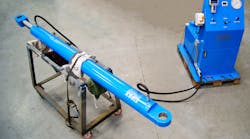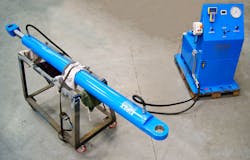Based in Dewsbury, West Yorkshire in the UK, Apex Hydraulics designs, manufactures, and repair of a wide range of hydraulic components, assemblies, and complete systems. Recently Apex was commissioned to produce some innovative safety equipment for the mining industry.
Although mining is notoriously dangerous for workers, the last few decades have seen huge improvements in safety from meticulous design failsafe systems in all operations. Naturally, then, safety features are a top priority for any new project.
Gypsum mining is a unique area of mining, with gypsum being accessed by drift mines—tunnels up to two miles long and sloping as much as 30 deg. Although steep, this incline allows vehicles to travel up and down without the need for elevators. As a safety feature, the tunnel has regular breaks of air locks, where vehicles must stop so personnel can open the doors, drive through, and close the doors behind them before opening the next door. This time-consuming feature is vital for the safety of the people in the mine.
This cylinder has a stroke of nearly 6 ft and can generate pull forces of 20 tons for testing the brake effectiveness of mining vehicles in the UK.
The Main Challenge
Mining operators identified a potential issue for vehicles when travelling out of the mine. These vehicles, which can weigh up to 90 tons, may spend months at a time in the mine before exiting for servicing or decommissioning. A vehicles must stop and wait while the air lock doors are opened and closed. Because of the steep slope, vehicle brakes must be in excellent working order to ensure that the vehicle can withstand repeated starting and stopping. Unfortunately, a vehicle’s brakes may not have been tested for some time, and a failure could result in accident, equipment damage, or injury.
To avoid this potential problem, a gypsum mining corporation needed equipment that could test vehicle brakes prior to the uphill climb to verify that brakes are in perfect working order and that the vehicle was capable of safely making the ascent out of the mine. For monitoring purposes, this proposed machine needed to register pressures and times so that the company could document the braking power of each vehicle.
The Equipment Design
Mining management spelled out the application needs to the Apex in-house design team. The final design was a hydraulic cylinder that could be secured to the floor or wall of the mine at its cap end, and with an attachment at its rod end that could be attached to the vehicle being tested. The cylinder has 140-mm (5.5-in.) bore, 80-mm (3.10in.) rod diameter, and 1,800-mm (71-in. stroke. At a working pressure of 200 bar, the cylinder can pull with a 20-ton of force
After the cylinder has been attached to the vehicle, the cylinder retracts while the vehicle resists through its brakes. The strength of these brakes is tested by a hydraulic power unit (HPU) designed specifically for this application. The HPU can log data though a laptop, which processes the data and produces a report. The report includes the pull forces and the amount of time the vehicle was subjected to the force. The forces can be adjusted for each vehicle. Once the data has been retrieved, mining personnel assess the safety of the vehicle to make the journey to the surface.
With the data provided by this equipment, mining vehicles can be thoroughly tested prior to their ascent, giving peace of mind to all operators and a full safety report to the mine management.
For information on products and capabilities offered by Apex Hydraulics, visit www.apexhydraulics.co.uk.



